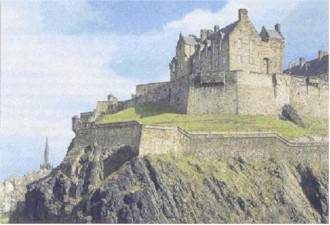
What to see at Edinburgh Castle
After the Tower of London, Edinburgh Castle is the next most visited ancient monument in Britain. From the battlements of the castle you get a panoramic view over the city of Edinburgh, laid out before you. Inside the walls is a remarkable fortress and former Royal residence, packed with history. Remember also that though the castle is a historic monument, it is also a working military establishment. The Scottish Division is headquartered here and is a military guard on the main gate.
- the Great Hall, with its ornate wooden ceiling, has a collection of armour and weapons
- the Crown Room with the Crown, Sceptre and Sword of State of Scotland
- the Royal apartments with an exhibition depicting Scottish history
- a small room in the Royal apartments where Mary Queen of Scots gave birth to her son, later James VI of Scotland and I of England
- the One O'clock gun fired daily (except Sunday) at the exact hour, to provide a time check for the city
- the Castle Esplanade, where the Military Tattoo is held in August every year
- St. Margaret's Chapel, a tiny Norman building, which has survived the various sieges of the castle
- a small iron wall-fountain; known as the Witches' Well, where women found guilty of witchcraft were put to death.
- Mons Meg, a massive fifteenth-century cannon, first used by James II to attack Threave Castle
History of Edinburgh Castle
The great volcanic rock on which the castle stands, rears high above the modern city. There is evidence of a Bronze Age settlement about 1000BC. The Roman army came here later.
- It was natural that a fort should be built on such a commanding and defendable site. We know that the fort was made of stone during the reign of Malcolm III (1058 to 1093).
- Edward I of England, in his efforts to conquer Scotland, took Edinburgh Castle in 1296, but in 1314 the Earl of Moray took the castle back for Scotland in a daring commando raid with only 30 men
- The English took it back in 1335, but in 1341 Sir William Douglas again removed the invaders. He tricked the garrison into thinking his band of men were merchants, they seized the castle and decapitated most of the English garrison
- The castle would now remain in Scottish hands until the Union of the Crowns in 1603. Attempts to take it were unsuccessful. In 1400 Henry V of England besieged the castle but had to withdraw to deal with a rebellion in Wales by Owen Glendower
- 1440 Edinburgh Castle was the site of the infamous "Black Bull's Dinner" where 16 year old sixth Earl of Douglas and his 14 year old brother David were murdered in front of their 10 year old King (James II). The death of Douglas was carried out by the ambitious Chancellor Crichton and was intended to break the Douglas power.
- The castle was further strengthened in 1573 and held out against an attack by the Covenanters in 1640, by Cromwell in 1650 and by the army of William and Mary in 1689.
- It continued to be strengthened and during Jacobite rising in 1745. Bonnie Prince Charlie's lack lustre efforts to take the castle were the last time that the castle came under attack
